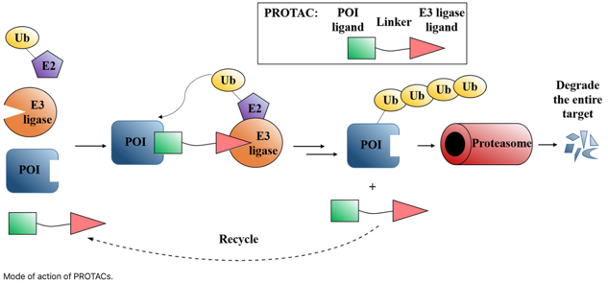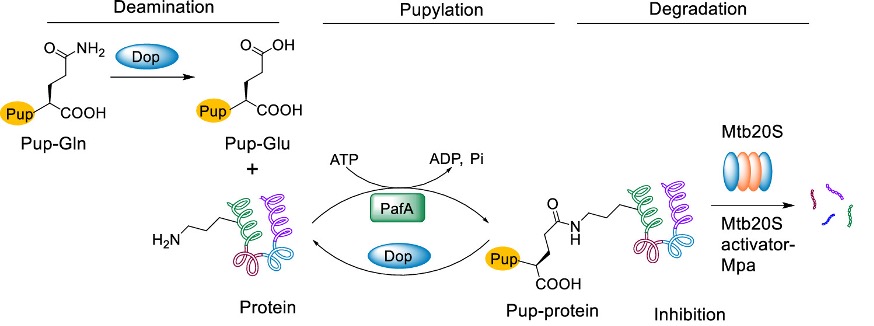



PROteolysis Targeting Chimeras (PROTACs) are a promising and recent technological development utilised in the degradation of proteins in eukaryotes. Application in bacterial pathogens however has been overlooked as protein degradation in this way was thought to be unique to eukaryotes. Recently it has become clear an exception to this exists, Mycobacterium tuberculosis and other actinobacteria, have been shown to possess a highly analogous degradation system. Consequently, this project will expand our current interest in Mycobacterium tuberculosis (Mtb) pathogen and focus on the development of MycoTACs, the first PROTAC like molecules for use in Mycobacterium tuberculosis.
PROteolysis Targeting Chimeras (PROTACs) are a promising and recent technological development. PROTACs are hetero bi-functional molecules, capable of recruiting a protein of interest and E3 ligase to promote the degradation of proteins via the ubiquitin-proteasome system in eukaryotic cells (Figure 1).

Figure 1: PROTAC mode of action in eukaryote cells
Whilst being actively developed for eukaryotes, their application in bacterial pathogens has been overlooked. Recently it has become clear that actinobacteria, including Mycobacterium tuberculosis, possess a highly analogous system. As a result, this project complements our current interest in this deadly pathogen and aims to develop MycoTACs, the first PROTAC molecules for use in Mycobacterium tuberculosis (Mtb).
Project
The Mtb proteolytic pathway is known as the Pup-proteasome system (PPS) and mirrors that of eukaryotes through proteasomal degradation following conjugation of a prokaryotic ubiquitin‐like protein (Pup), a small (7 kDa) and natively unstructured protein (Figure 2).

Figure 2: Schematic representation of the Pup-proteasome system (PPS) in Mtb
Pup shares no homology to ubiquitin and where hundreds of ubiquitin ligases exist, only one enzyme, proteasome accessory factor A (PafA), conjugates Pup to bacterial protein targets. Consequently, to develop our MycoTACs we are working through four objectives.
Objective 1: This will enhance our existing in silico library of PafA recruiting molecule(s) utilising computational modelling. To achieve this, in silico docking will utilise the Alphafold model of Mtb PafA, CCDC software (GOLD/Hermes) and the ZINC online compound library.
Objective 2: Running concurrently with objective one, synthesis of PafA recruiting molecule(s) that have already demonstrated good in silico binding to PafA will be undertaken, alongside those identified in objective 1. Once prepared, the molecules will be screened for their binding efficiencies and biological properties against recombinant PafA and Pup in an established Pup conjugation assay. Whilst this is the main objective, these molecules will also be screened for their antibacterial activity against Mtb, as inhibiting the proteasome has been shown to be an effective strategy.
Objective 3: Having access to recombinant PafA enables us to undertake crystal trials and ultimately determine the structure. Being able to produce a crystal will have many benefits, such as substitution of the Alphafold model and revalidation of our model compounds to crystal soaking experiments with molecules from objective 2 to validate the chosen in silico binding site (EP).
Objective 4: With a PafA recruiting molecule(s) identified, we will conjugate these to existing drug molecules, identified for their ability to target essential pathways in Mtb. This will provide the final MycoTAC chimaera suitable for antibacterial screening as in objective 2 to validate these tools as bacterial PROTACs.
Strategic vision
Tuberculosis is the deadliest human disease, with 1.5 million people succumbing to this disease in 2021. Identifying novel proteins involved in essential biochemical pathways is of the utmost importance in Mtb, the causative agent of tuberculosis. Recent studies demonstrating the Mtb proteome provides such an opportunity validates our project aims and any results from these computational, chemical, and biological studies would be important to the field.

Biosciences Institute
Faculty of Medical Sciences
Newcastle University
Cookson Building
Newcastle-upon-Tyne
NE2 4HH, UK
Tel.: +44 (191) 2082357
Email: jon.sellars@newcastle.ac.uk
///blast.palace.cycles